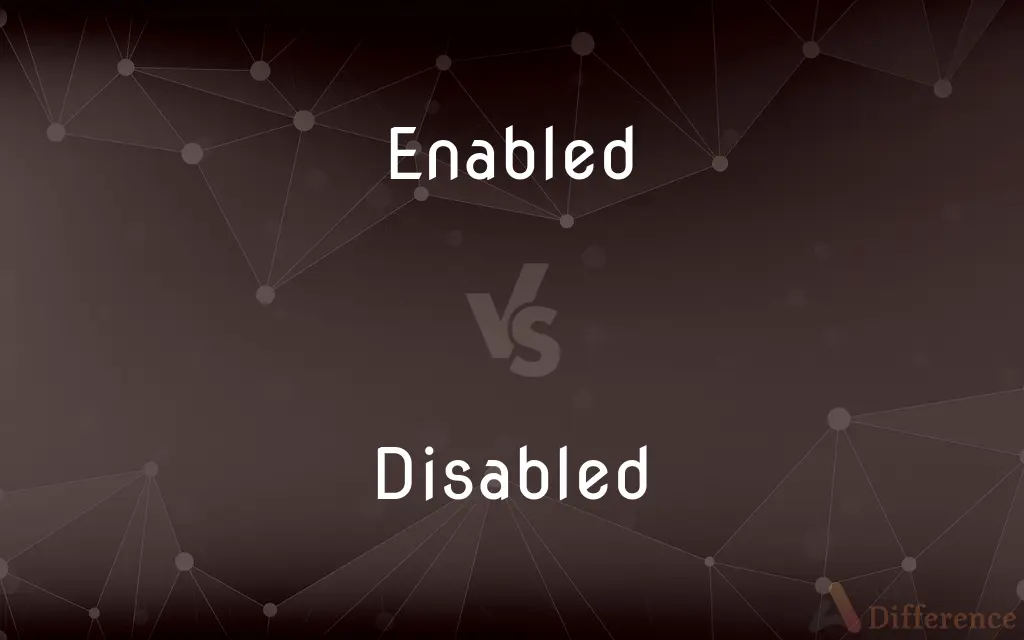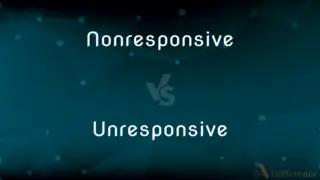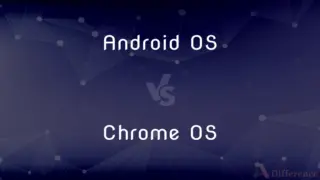Enabled vs. Disabled — What's the Difference?
By Tayyaba Rehman — Updated on October 5, 2023
Enabled means making something operational or giving someone the means to do something, while Disabled means rendered non-functional or depriving someone of capabilities.

Difference Between Enabled and Disabled
Table of Contents
ADVERTISEMENT
Key Differences
Enabled, in its essence, implies that something has been turned on, made operational, or given the means to function effectively. For instance, when a software feature is turned on, it's said to be enabled. On the contrary, Disabled means that something has been turned off, made non-operational, or deprived of its function. A broken machine, for example, could be described as disabled. In the context of people, Enabled often refers to providing individuals with tools or resources to accomplish a task. Conversely, Disabled can denote an impairment in physical or mental function, though it's crucial to approach this usage with sensitivity, considering the person before the disability.
When one talks of features in tech products or services, Enabled denotes that the particular feature is active and ready to use. In comparison, Disabled indicates the feature is turned off or not operational. When we consider accessibility and inclusivity, an enabled environment means that specific adjustments or accommodations have been made to include everyone, regardless of their abilities. However, a disabled environment might be one where such provisions aren't available, potentially excluding individuals with certain impairments.
Another perspective is that of empowerment. When people are enabled, they are empowered with the tools, resources, or skills needed to perform a particular task or role effectively. This implies a positive, proactive stance towards equipping individuals. On the flip side, when someone or something is disabled, it might indicate a barrier or challenge in performing a task, often due to external factors.
Lastly, it's essential to note the evolving nature of language, especially around terms that relate to individuals' identities. Enabled and Disabled, when referring to people, should be used with care, keeping in mind the principle of person-first language, emphasizing the individual before any condition or disability they might have.
Comparison Chart
Definition
Made operational or given the means
Rendered non-functional or deprived
ADVERTISEMENT
Nature
Positive, operational
Negative, non-operational
Usage
In contexts indicating functionality or empowerment
In contexts indicating non-functionality or barriers
Examples
Enabled feature, enabled individual
Disabled feature, disabled individual
Grammar
Typically used as a verb or adjective indicating action or state
Used as a verb or adjective indicating a lack of action or state
Compare with Definitions
Enabled
Made functional or operational.
The update enabled new features in the app.
Disabled
Rendered non-functional.
The broken button was disabled and needed repair.
Enabled
Allowed or permitted.
The system enabled users to customize their profiles.
Disabled
Having a physical or mental condition limiting movement, senses, or activities.
Disabled individuals often face challenges in non-inclusive environments.
Enabled
Made capable or empowered.
The training enabled her to handle the software proficiently.
Disabled
Turned off or deactivated.
The feature was disabled in the latest version.
Enabled
Activated or turned on.
The setting was enabled by default.
Disabled
Deprived of power or effectiveness.
The outage disabled the entire network.
Enabled
To supply with the means, knowledge, or opportunity (to do something); make able
A hole in the fence that enabled us to watch.
Techniques that enable surgeons to repair the heart.
Disabled
Prevented from taking action or functioning.
He was temporarily disabled by the sudden pain.
Enabled
To make feasible or possible
Funds that will enable construction of new schools.
Disabled
Having become or having been rendered inoperative
A disabled vehicle.
Enabled
To give legal power, capacity, or sanction to
A law enabling a new federal agency.
Disabled
Having a disability
A disabled veteran.
Enabled
To make operational; activate
Enabled the computer's modem.
Enable a nuclear warhead.
Disabled
(used with a pl. verb) People with physical or mental impairments, considered as a group. rights of the disabled.
Enabled
To behave in a manner that facilitates or supports (another's abusive, addictive, or self-destructive behavior).
Disabled
Made incapable of use or action.
Enabled
Being capable for use or action; not disabled
Disabled
Having a disability.
Enabled
(computing) Adapted for use with the specified mechanism or system.
Disabled
(legal) Legally disqualified.
Enabled
Simple past tense and past participle of enable
Disabled
(nonstandard) One who is disabled. often used collectively as the disabled, but sometimes also singular
Enabled
Given the tools or means.
He was enabled with the right resources to succeed.
Disabled
Simple past tense and past participle of disable
Disabled
Injured so as to be unable to function; as, disabled veterans.
Disabled
Unable to function at normal capacity.
Disabled
People who are crippled or otherwise physically handicapped;
Technology to help the elderly and the disabled
Disabled
Incapacitated by injury or illness
Disabled
So badly injured as to be unable to continue;
Disabled veterans
Common Curiosities
Can enabled mean empowered?
Yes, to be enabled can mean to be given the tools, resources, or skills to perform effectively.
How is enabled different from activated?
While both terms can mean turning something on, enabled often implies giving the means to function, whereas activated usually just means turning on.
Can a person be enabled?
Yes, when a person is enabled, they're often given the resources, tools, or skills needed for a particular task.
How should one approach the topic of disability?
It's essential to approach the topic with sensitivity, respect, and using person-first language.
What does it mean when someone is referred to as disabled?
Referring to someone as disabled typically means they have a condition limiting their movement, senses, or activities, though it's essential to prioritize person-first language.
Is the term disabled always negative?
While disabled can refer to non-functionality, when referring to people, it's a neutral descriptor, but it's crucial to approach with sensitivity and use person-first language.
Is disabled the opposite of enabled?
In many contexts, yes, disabled can be considered the opposite of enabled.
How does society enable or disable individuals?
Society can enable individuals by providing resources, opportunities, and inclusive environments or disable them by creating barriers, limiting resources, or maintaining non-inclusive settings.
How is the word enabled used in technology?
In technology, enabled often refers to a feature or function being active or operational.
Can a feature in software be disabled?
Yes, a feature in software can be turned off or made non-operational, thus being described as disabled.
Share Your Discovery

Previous Comparison
Nonresponsive vs. Unresponsive
Next Comparison
Appetizer vs. DessertAuthor Spotlight
Written by
Tayyaba RehmanTayyaba Rehman is a distinguished writer, currently serving as a primary contributor to askdifference.com. As a researcher in semantics and etymology, Tayyaba's passion for the complexity of languages and their distinctions has found a perfect home on the platform. Tayyaba delves into the intricacies of language, distinguishing between commonly confused words and phrases, thereby providing clarity for readers worldwide.















































